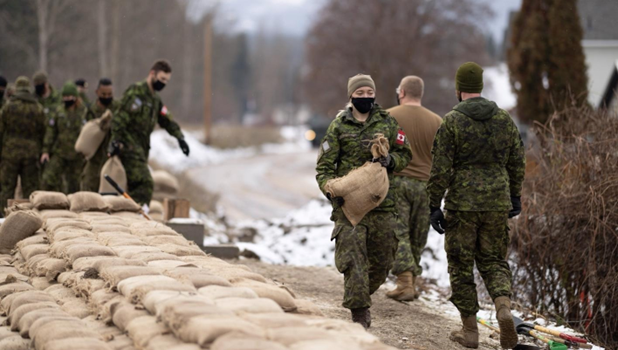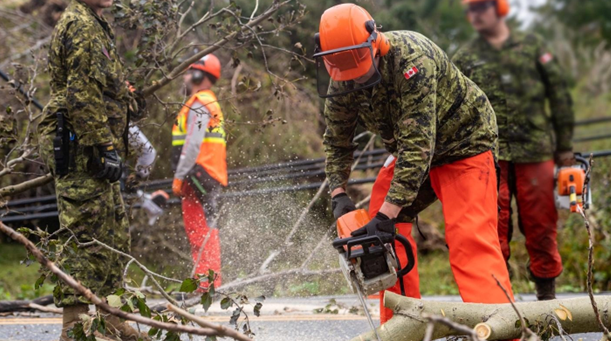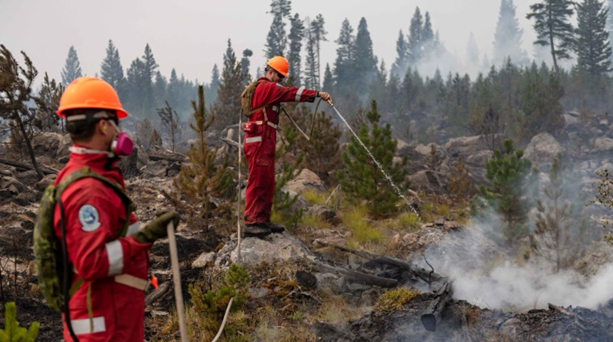How Defence Spending Can Strengthen Critical Infrastructure
Author(s):
Josh Grignon
Olivia Caruso

Disclaimer: The French version of this text has been auto-translated and has not been approved by the author.
With extreme weather escalating and Canadian Armed Forces deployments on the rise, NATO defence spending should be directed toward resilient infrastructure that supports both municipal capacity and military readiness.

Members of Lord Strathcona’s Horse (Royal Canadians) reinforce a riverbank with sandbags during Operation LENTUS in Princeton, British Columbia, November 25, 2021. Photo by Pte. Daniel Pereira. © His Majesty the King in right of Canada, as represented by the Minister of National Defence (2021). All rights reserved.
Climate Change and Security
The United Nations calls climate change the defining issue of our time. Its impacts are becoming clearer every year, as extreme weather events grow more frequent and more severe. Nowhere are the consequences felt more sharply than in cities, where high concentrations of people, services, businesses, and infrastructure make urban areas especially vulnerable.
Canada is facing increasingly severe and costly extreme weather events. There is a clear trend of growing climate-related impacts, with 2024 marking the worst year on record. Critical infrastructure is at particular risk, with energy systems, transportation routes, water networks, and communications experiencing more frequent damage and disruption, demanding ever greater resources to maintain and repair.
Requests for military assistance during natural disasters have sharply increased over the past decade, with Canadian Armed Forces (CAF) deployments roughly doubling every five years since 2010. Notable examples of CAF involvement in protecting and assessing critical infrastructure include:
- 2019 – Floods in Ontario, Quebec, and New Brunswick: Around 2,500 personnel supported sandbagging, clearing roads, and checking infrastructure during widespread flooding.
- 2021 – British Columbia floods: CAF members helped protect a pumping station and rail lines, conducted dike inspections, and carried out rapid infrastructure damage assessments.
- 2022 – Hurricane Fiona (Atlantic Canada): Approximately 1,000 CAF personnel conducted damage assessments, cleared debris from roadways, and supported efforts to restore essential services.
During testimony before the House of Commons Standing Committee on National Defence, Minister Bill Blair emphasized that the rising demand for disaster response has significantly reduced the CAF’s capacity to meet other duties. Chief of the Defence Staff General Wayne Eyre added that increasingly frequent call-outs are undermining the military’s primary role of defending against external threats.
As Christian Leuprecht of the Royal Military College notes, “we now have provinces that send requests for assistance before storms even hit,” a sign that provinces and municipalities increasingly view the military as a default response and do not believe they have the capacity to cope on their own. Extreme weather is also weakening readiness by damaging the public infrastructure the CAF relies on, especially power grids and transportation networks, creating choke points that disrupt movement and operations.
NATO has identified climate change as a major security threat and made it a core part of its strategy, recognizing that environmental risks directly affect military capacity and effectiveness. Building resilience through early investment, stronger infrastructure, and greater municipal capacity is critical to reducing demand on the military, strengthening domestic security, and fulfilling our commitment to collective defence.

Members of the Canadian Armed Forces assist with relief efforts in Nova Scotia during Operation LENTUS after Hurricane Fiona, September 27, 2022. Photo by Cpl. Connor Bennett. © His Majesty the King in right of Canada, as represented by the Minister of National Defence (2022). All rights reserved.
Infrastructure Procurement Challenges
Critical infrastructure in Canada is managed through multi-level governance, with responsibility shared across federal, provincial, municipal governments and private operators. Provinces and municipalities manage most roads, electricity is delivered through a mix of Crown corporations and private firms, and telecommunications are largely private but federally regulated. These same systems are also vital to CAF operations, which depend on public infrastructure, creating risks if those assets are disrupted or targeted.
Critical infrastructure is built and maintained through public tenders and contracts, often awarded to private firms, either directly or as part of public–private partnerships. For example, when a new highway is needed, a provincial government issues a request for proposals, private construction firms bid, and the winning bidder builds the road. Long-term asset management then helps ensure these systems remain reliable for civilians and, incidentally, the CAF.
Public procurement of critical infrastructure is dominated by the lowest-bid model, with many municipalities required to accept the cheapest proposal. And climate resilience considerations are only beginning to be incorporated into procurement processes and are not yet a consistent requirement. The combination of lowest-bid procurement and the absence of resilience criteria discourages adaptive planning, limits investment in research and innovation, and leaves critical infrastructure less prepared for future impacts.

Members of the Domestic Response Company conduct Type 3 firefighting under BC Wildfire Service supervision at the Flat Lake Fire near 100 Mile House, British Columbia, during Operation LENTUS on August 18, 2021. Photo by Sailor 1st Class Victoria Ioganov. © His Majesty the King in right of Canada, as represented by the Minister of National Defence (2021). All rights reserved.
Resilient Dual-Use Infrastructure
The rising frequency of extreme weather and repeated CAF deployments, combined with limited investment in resilience for critical infrastructure, demand a shift in Canada’s approach to funding and procurement. All critical infrastructure projects should embed climate resilience, including research and development into new technologies and innovative strategies. Building local capacity to withstand and respond to disasters would reduce dependence on military resources and strengthen overall readiness.
All NATO members, including Canada, have agreed to raise defence spending to reach a new target of 5% of GDP by 2035. NATO counts not only defence budgets but also operational deployments, infrastructure, and other security-related investments toward this goal. A portion of Canada’s additional funding should be directed toward building resilience into dual-use infrastructure that serves both public needs and CAF operations.
One way to achieve this is through a defence–civilian co-funding mechanism — a cost-sharing model where defence dollars help provinces and municipalities strengthen local projects against extreme weather. Under this approach, defence funding would supplement procurement budgets to add resilience features, with requests for proposals requiring bidders to demonstrate how their designs address climate risks. The United States already has a precedent through its Defence Access Roads program, which pays for upgrades to public roads needed for military use. Canada could set itself apart by explicitly integrating climate resilience into such a model — strengthening both public safety and CAF readiness.
Other NATO partners are already advancing dual-use infrastructure initiatives. In Italy, the $14.7 billion USD Messina Bridge will connect Sicily and Calabria by road and rail, with Rome seeking to classify it as military spending to meet NATO targets. In Germany, an additional 1.5% of GDP is earmarked for roads, bridges, and other projects that serve both civilian mobility and military logistics. And across the European Union, $670 million USD has been allocated to 35 transport upgrades on the Trans-European Network to enhance both trade and defence mobility.
Together, these examples show that aligning infrastructure investment with military readiness is already becoming a norm among NATO allies. Canada should go further by ensuring that every new investment is not just dual-use but also climate-resilient — turning defence spending into a tool for stronger communities, improved military readiness, and greater resilience in the face of extreme weather.

